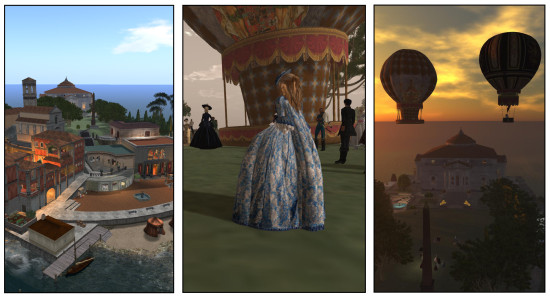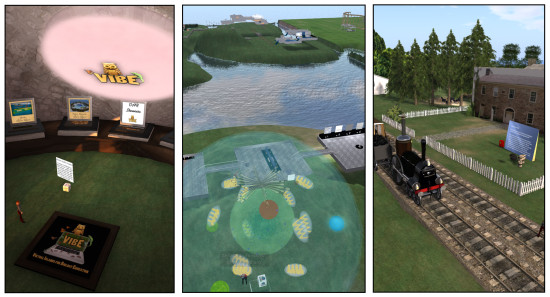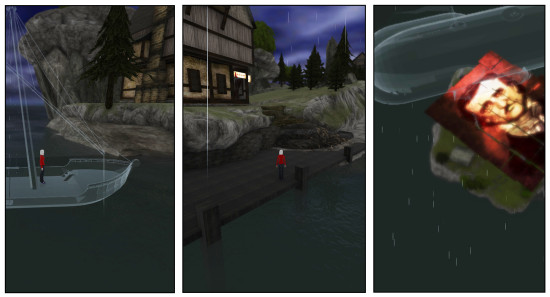Much has been said about using virtual environments for teaching and training. While it is an inescapable fact that no environment, real or virtual, can make up for a dedicated, well-prepared teacher with a passion for their subject matter, there is merit in the concept that a virtual environment can open new pathways for learning by engaging the student with the creation and exploration of ideas in 3D.
What makes a great virtual environment for teaching? In this blog post, we will seek answers to that question across three platforms: Second Life, OpenSim and Cloud Party. We will look for the common denominators and the differences between these spaces and note how they each leverage the platforms they stand on to create a purposeful, dynamic and educational experience.
How do virtual environments teach?
All these platforms offer a “sandbox†approach, allowing students to build and explore other people’s builds, and as the students build the environment, they learn the about land, architecture, and the requisite modeling and coding skills.
Virtual environments teach by immersion, or the experience of being completely surrounded by the sounds and sights of a virtual world. When students role-play in a historical reenactment, they are learning about the history and cultures of other peoples, and become a supporting part of the lesson itself.
If the ultimate goal is to create a learning place that engages the interest of a student immediately and helps them increase understanding of the subject matter, then the factors that spark curiosity, attract interest, prolong engagement, and support instructional scaffolding and learning progression must be there.
Let’s travel over to Second Life first and visit the island of Rocca Sorrentina.
Environment 1 – Rocca Sorrentina in Second Life

Sometimes the best way to understand cultural history is to live in it for a little while. The Missouri Humanities Council and Laboratory for Virtual Arts and Humanities sponsors an environment that supports this kind of learning with a fictitious island in the spirit of the 18th century Age of Enlightenment called Rocca Sorrentina.
Fostered by Aldo Stern (Geoff Giglierano) and Serenek Timeless, this multifaceted build intertwines palatial reception areas, public shops, archeological and scientific displays and all that embraces the worldly sophistication of European life in the 1700’s.
To paraphrase Serenek, “this is a Montessori school for adults.†In essence, the members of the Rocca Sorrentina community are deeply engaged in the co-creation of a place where many aspects of 18th century life can be explored, and as they build content, role-play, and discover the arts and culture of the period, their knowledge grows. As Geoff says “this is a continually evolving experiment in which we hope to better understand how people learn and acquire, share, and process ideas and information in a virtual environment.â€
They utilize the Destination guide and listing keywords to attract international visitors who are interested in Italy, and the 18th century. Free period clothing is provided to help with the historical immersion. The active community supports collaborative and continuous engagement for its visitors, and deeper learning about the milieu is enhanced by the provisioning of cultural information on notecards and artifacts from the period.
Recently, they reenacted the first duel fought in hot air balloons, synchronizing that with the opening of an exhibit entitled “The Aeronauts: 18th Century Ballooning and the Beginnings of Flightâ€. This being a fine example of the community working together to explore the history of the 18th century, role-playing and creating learning experiences for each other that is supported, and deepened with the assistance of the sponsors.
Environment 2 – VIBE in OpenSim

OpenSim has become a vast landscape filled with experimentation in educational virtual environments. The Virtual Islands for Better Education, (VIBE) on the OpenSim platform is the result of collaboration among various schools and educators to create learning tools within a virtual environment, under the leadership of Stephen Gasior who can be contacted here. VIBE has created its own hypergrid network to support that collaboration, and open the accessibility to their regions. Visitors can register here for their accounts.
The overarching design methodology, it to create an immersive virtual lesson about science related subjects supported by interactive elements and object manipulation. The lesson environments are designed for simplicity of use which reduces the training time with the virtual world browser.
Starting from the initial landing hub the visitor can access several regions including the Global Health Grid/East Africa Traveler’s Safety Activity, Project Alexandria, Genome Island, BIOME, and Nova Archeology. All are great examples of what inspired teaching can bring to the virtual world. Here are a few snapshots of the sims in VIBE.
Project Alexandria, created by Joe Graham in collaboration with Eva Comaroski (scripting for framework and import service), is an open library organized by floating islands that visually designate the topic matters of the books they store. For instance, horror books are over by the gravestones, children’s books are denoted by resident fairies, and the sci-fi section has steampunk décor.
Genome Island, built by Mary Ann Clark is dedicated to teaching genetics with interactive displays that enable the student to gather data for analysis and hypothetical theorizing. Still under development, the OpenSim version contains a model biological cell, complete with interactive components.
Nova Archeology contains many displays relating to all aspects of archeology, including several virtual reconstructions of dwellings from various periods in time. Currently under development is a virtual representation of the Allegheny Portage Railroad circa 1860, Pennsylvania. This is being created from real life scans of the actual site in the real world by Marion R. Smeltzer, a project in collaboration with the National Parks Service.
Environment 3 – “Mind of Poe†EduScene

Changing the virtual world paradigm, Cloud Party started its web browser based virtual world in 2011. This “2nd generation†virtual world offers some interesting features to the educator who would like to build an educational environment.
In the “Mind of Poeâ€, the visitor will find a floating island full of mystery and a unique way of discovering the literature of Edgar Allan Poe. At the landing point of this immersive build, the visitor may take a ghost ship and sail to a series of cottages wherein they can discover the aspects of Poe’s great stories, such “The Ravenâ€, “The Black Catâ€, and “The Tell-tale Heartâ€. All the “story spaces†incorporate audio book readings as well as ambient music to set the mood. The island can be further explored in the ghost airship hovering above all.
This virtual environment was built by Tessa Kinney-Johnson, AirisApps LLC, and Dave Fliesen, with the intent of supporting a Constructivist approach to learning literature for high school students. Blowing a little dust off the venerable works by Mr. Poe, this build makes his literature accessible in a more dynamic way, appealing to today’s high school student with its explorative game like design. Future plans include the development of a 3DMOOC network utilizing Cloud Party as the platform.
Conclusion
One common denominator in all of these environments is the great passion with which they are all created. In each one, there is clear evidence that the creators know their subject, and are eager to share information about it. Also, each build utilizes the best qualities of their platform to enhance the content, access and interactivity.
Finally, every builder, mentor, or teacher involved with these shares a commitment to the development of virtual worlds as an experiential learning environment.
- Oculus viewers updated, still not building-friendly - June 6, 2014
- In-world with the Oculus Rift - March 30, 2014
- 5 tips for video tutorials and 3D simulations - February 17, 2014
